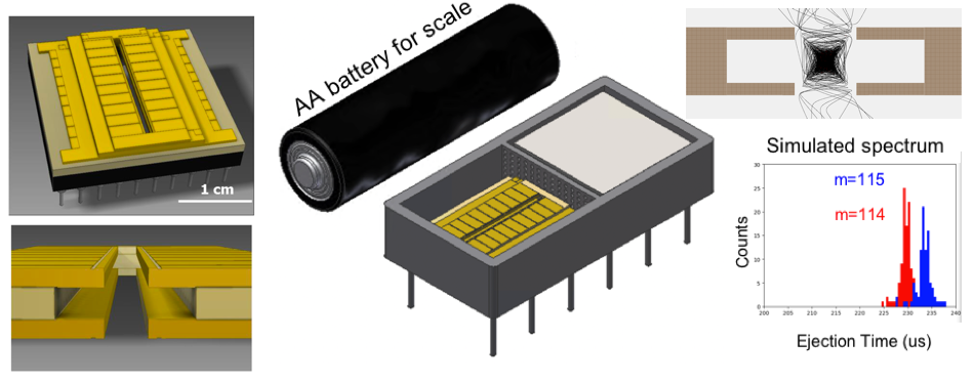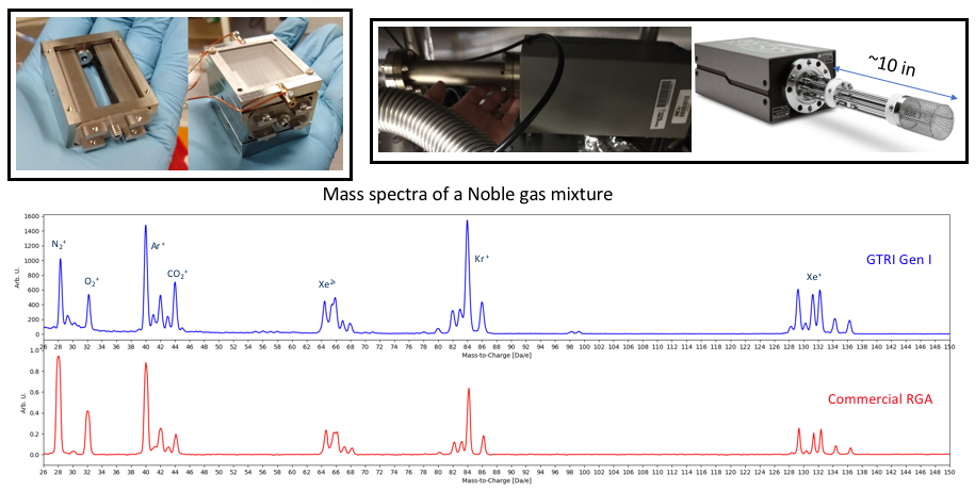With its miniaturized size, this chip-scale linear ion trap could enable development of truly portable or wearable mass spectrometers that could significantly advance the industry’s state of the art. Used as a mass analyzer in mass spectrometers, Georgia Tech’s innovation boasts lower size, weight, and power requirements while retaining all of the performance characteristics of standard-scale analyzers. These advances address a current gap in the extension of mass spectrometry to portable devices by dramatically reducing their size, weight, and power. Fully realized, the technology could be a springboard for micro-scale mass spectrometers that could be carried by soldiers or emergency personnel, mounted to uncrewed aerial vehicles, deployed in the field in networked arrays, and even leveraged by industries and applications in which larger spectrometers are not currently practical.
- Enabling: Can be used in the development of much smaller mass spectrometers than are currently available—from benchtop devices to handheld or even smaller instruments—which would extend their use to applications in which they are not currently cost effective
- High-performance: Provides better than unit-mass resolution and high detection efficiency, and operates at much higher pressures than larger mass analyzers, as shown during lab-based simulations
- Multi-modal: Allows for several different modes of operation and enables tandem(MS/MS or MS2) or multi-stage/sequential (MSn) mass spectrometry, greatly improving capability compared with other analyzers
- Convenient: Can be microfabricated using well-established microelectromechanical system (MEMS) techniques
- Impactful: Provides immediate reduction in the size of current instruments, even before miniaturization of the other needed subcomponents (e.g., vacuum pumps, gas handling valves)
- Robust: Helps reduce the requirements of vacuum pumps, which are very difficult to microfabricate, with expected effective operation up to 10 Torr
Environmental analyses, including:
- Detection of chemical and biological weapons, explosives, and toxic industrial chemicals
- Monitoring of pollution, air quality, soil contamination, drinking water quality, and food processing facilities
- Data collection for ocean studies and trace elemental analyses
- Characterization of vehicle cabin atmospheres (e.g., aircraft and spacecraft)
Clinical, pharmaceutical, and biological uses, including:
- Drug development
- Cancer/Disease screening
- Detection of biomarkers and infectious agents
- Characterization of complex proteins
- Peptide sequencing
Military, law enforcement, and forensic uses, including:
- Detection of trace evidence
- Arson investigations
- Identification of explosive residues
- Detection of illicit drugs
- Detection and monitoring of chemical and biological weapons
Fundamental research, including:
- Nuclear technologies and oversight of nuclear facilities
- Astronomical studies
- Fundamental physics and chemistry research
Mass spectrometers allow the chemical constituents in a sample to be determined, and as such they have wide-ranging applications in the modern world. Unfortunately, a portable mass spectrometer that could be carried by a person or mounted to small vehicles does not currently exist. A chip-scale mass spectrometer would truly revolutionize what is possible with these devices and the industries they could serve. Although other mass spectrometer subcomponents still need to be miniaturized in order to fully realize a chip-scale device, Georgia Tech’s chip-scale mass analyzer in and of itself can immediately reduce the size and weight of any mass spectrometer it is used in, bringing the industry significantly closer to realizing portable devices.
How It Works
Georgia Tech’s chip-scale linear quadrupole ion trap is a mass analyzer—the heart of a mass spectrometer that ultimately determines the instrument’s overall ability to discern a sample’s constituents. (Notably, the inventors are aware of only three other truly chip-scale mass analyzers, but—unlike the Georgia Tech innovation—those devices’ performance characteristics are not yet at the level where they can provide useful mass analysis.)
Key to this innovation’s utility and performance is a particular geometry that produces a highly quadrupolar potential despite the use of flat, rectangular-shaped electrodes. This is in contrast to the round or hyperbolic-shaped electrodes used in most larger commercial mass spectrometers. Georgia Tech’s ion trap simultaneously traps a large range of particles with varying m/z values and then ejects them from the trap in a mass-dependent way so that they can be detected. In addition, by putting the linear ion trap on a chip, Georgia Tech has made it possible to have separate regions of the chip where the ions are created, analyzed, and detected because the ions can be moved through different regions with the use of additional DC voltages.

A concept design for Georgia Tech’s chip-scale linear quadrupole ion trap mass analyzer, and simulations of the trap performance.

Proof of concept of the novel ion trap mass analyzer. Georgia Tech’s Gen I is 10x larger than the chip-scale version and was made from traditionally machine parts. It was mounted in the same vacuum chamber as a commercially available quadrupole mass filter analyzer (SRS RGA). A mixture of noble gases was introduced into the chamber. The blue data is the resulting spectrum from Georgia Tech’s Gen I analyzer, while the red data is that obtained by the SRS RGA.
